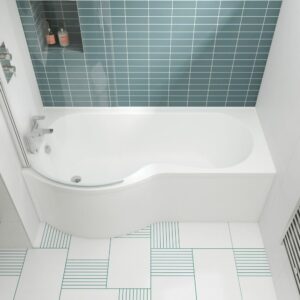A gleaming bathtub can transform your bathroom from an everyday chore into a luxury retreat ripe for self-indulgence and relaxation. Yet, that indulgence could quickly vanish in the sight of soap scum and stubborn grime making a home in your tub. Do not worry; this step-by-step guide from Showers to You will turn the tide on tarnished tubs, ensuring your sanctuary spot is always in mint condition. Welcome to the comprehensive guide on cleaning a bathtub, a task that might be less glamorous but undoubtedly essential. 
Materials Needed for the Mission
Before you plunge into the process, gather your cleaning arsenal. The materials you’ll need include:
- Baking Soda: A staple of the household that’s a gentle abrasive, perfect for lifting dirt without damaging the tub’s surface.
- Paper Towel or Dry Cloth: Ideal for drying and applying cleaning solutions.
- Spray Bottle: To contain your cleaning concoctions, making application a breeze.
- White Vinegar: A natural, non-toxic, and highly effective deodoriser and cleaner against mould and mildew.
- Non-abrasive Cloth or Sponge: For gentle but thorough scrubbing without scratching your bathtub.
Step 1: Preparing the Area
First things first, clear your bathtub of any personal items, toys, or bathmats. The goal is to have a clean slate—well, a clean tub—to work on. Remove any residues of shampoos or soaps which might interfere with your cleaning process. Then, give the surrounding space a quick wipe to clean the dust that may find its way into the freshly cleaned tub.
Step 2: Choosing the Right Cleaning Agents
The cleaning requirements for your bathtub will depend on the material from which it is made. Here are a few recommendations:
- Porcelain Tubs: Gentle scrubbing with a baking soda paste or white vinegar solution is usually safe.
- Fibreglass and Steel Tubs: Use a mild, non-abrasive detergent with a soft cloth to clean to avoid scratching.
- Acrylic Tubs: Stick to gentle, non-abrasive cleaning agents to maintain their glossy finish.
- Stone and Marble Tubs: Opt for pH-neutral cleaners designed for these materials to avoid damage.

Step 3: Scrubbing and Cleaning
This is the part where elbow grease meets effective technique. Here’s how to approach scrubbing for different materials:
- Porcelain, Fiberglass, and Acrylic Tubs: Create a paste with baking soda and water, spread it around the tub, and scrub with a cloth or sponge. A vinegar spray followed by a baking soda paste can work wonders for stubborn stains.
- Stone and Marble Tubs: Use a stone cleaner or a mild soap solution, avoiding any abrasive substances that could mar the surface.
Remember to pay extra attention to the water line, the area around the drain, and the underside of the bath filler. A dedicated limescale remover can be employed for any limescale build-up.
We also have a detailed guide on how to clean a shower tray using a similar method.
Step 4: Rinsing and Drying
Once the scrubbing is done, it’s time to wash away the cleansers. First, clean water is used to remove the cleaning agent, and second, white vinegar is used to neutralise any remaining chemicals.
Do Not Skip The Drying Step! Moisture can breed mould and mildew, undoing all your hard cleaning work. Use a dry cloth or paper towel to remove the water and buff the tub to a shine.
Step 5: Maintenance Tips
You’ve managed the major clean-up; now, it’s all about maintenance. Here are some tips:
- Keep a squeegee near the bath and quickly remove water after each use to prevent water spots and build-up.
- Regularly clean your bathtub—it’s easier to maintain a mildly dirty tub rather than tackle deeply ingrained dirt and stains. Depending on how many people use it, we suggest cleaning it every week or fortnight.
- Place a bowl of baking soda in your clean, dried tub for a natural, fresh scent. It absorbs any odours and adds a light, clean fragrance.
Explore our detailed cleaning guides for a pristine bathroom. Discover “How to Clean a Showerhead,” ensuring optimal water flow. Learn the art of streak-free reflections with “How to Clean a Bathroom Mirror.” Elevate your chrome’s shine with “Five Tips for Cleaning Bathroom Chrome Fittings.” Our expertise is your sparkling sanctuary.
 FAQ
FAQ
How often should I clean my bathtub?
A good rule of thumb is to give it a mild cleaning every week with more intensive scrubbing once a month, depending on how frequently the tub is used.
Do you need bleach to clean a bath?
Bleach can be used to clean your bathtub if necessary, particularly for removing mould or mildew stains. Always ensure sufficient ventilation and be cautious about mixing with other cleaning agents. However, Showers to You recommends using the homemade solution of baking soda and white vinegar as a bleach alternative.
How do I get my bathtub white again?
Combining baking soda and white vinegar is usually effective at restoring whiteness. Use a bleach solution, or consider a professional deep clean for tougher stains if you have concerns about your tub’s material.
Conclusion
A pristine bathtub is not just about aesthetics—it’s about hygiene and creating a restful space in your home. Follow this detailed guide, armed with the proper knowledge and tools, and your bathtub will be a focal point in your bathroom.
Now that you know the process, why not shop for baths at Showers to You? Transform your cleaning jigsaw into a lascivious luxury purchase and take the cleanliness of your bathroom to the next level. Your next bath will thank you! Get in touch with one of our experts today via email at info@showerstoyou.co.uk, by phone at 01472 242159, or through our online contact form.